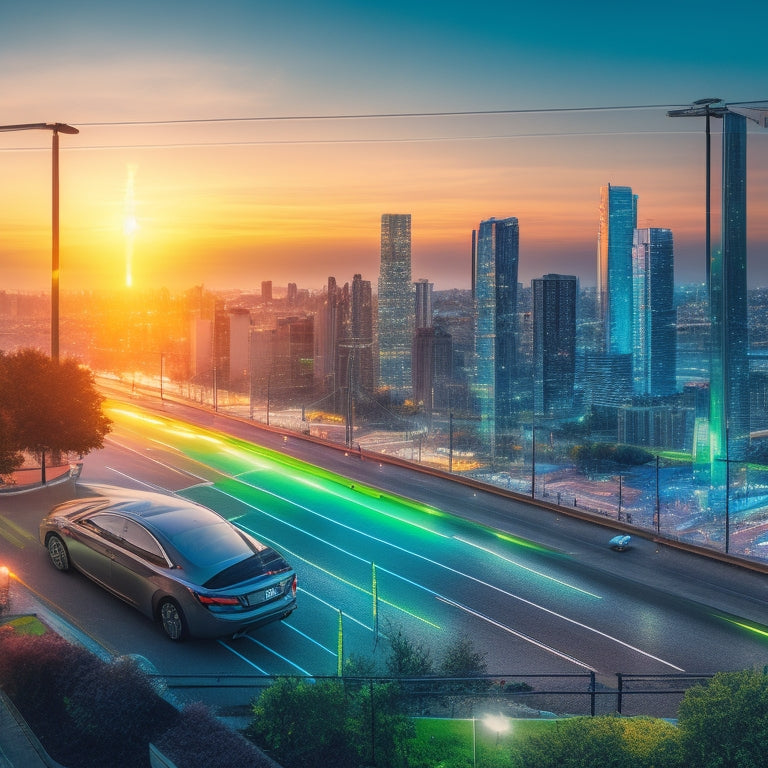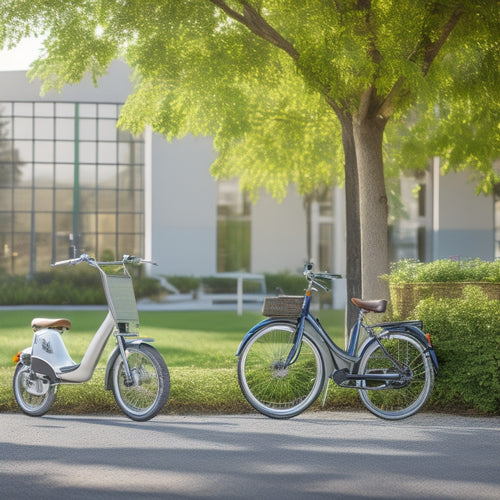
10 Best Opportunities Driving Vehicle to Grid Growth
Share
As you explore the vehicle-to-grid (V2G) landscape, you'll find that a convergence of technological advancements, policy reforms, and shifting consumer preferences is opening up unprecedented opportunities for growth. Top opportunities driving V2G growth include government incentives boosting adoption, renewable energy integration advantages, peak demand management benefits, and vehicle battery cost reductions. Additionally, electric grid resiliency enhancement, smart city infrastructure development, greenhouse gas emissions reduction, microgrid energy storage solutions, and increased electric vehicle adoption are all contributing to the expansion of the V2G market. As you continue, you'll uncover more insights into the complex dynamics shaping this rapidly evolving field.
Key Takeaways
• Government incentives, such as tax credits and relaxed regulations, drive V2G adoption by reducing upfront costs and encouraging innovation.
• Integration of renewable energy sources stabilizes the grid, optimizes energy distribution, and reduces reliance on fossil fuels, promoting V2G growth.
• Peak demand management benefits, including load balancing and energy efficiency, make V2G an attractive solution for grid resilience and cost reduction.
• Decreasing vehicle battery costs, driven by advancements in lithium-ion technology, increase the feasibility and adoption of V2G technology.
• Smart grid infrastructure development, including real-time monitoring and energy storage, enhances grid resilience and supports widespread V2G integration.
Government Incentives Boost Adoption
As governments worldwide introduce policies and incentives, you're more inclined to explore investing in vehicle-to-grid (V2G) technology, driven by the promise of financial benefits and reduced emissions.
Governments are recognizing the potential of V2G to stabilize the grid and reduce greenhouse gas emissions, and are offering attractive incentives to encourage adoption. One such incentive is tax credits, which can greatly offset the upfront costs of V2G infrastructure. For instance, the US offers a 30% tax credit for V2G equipment and installation costs.
Regulatory reforms are also playing an essential role in driving V2G adoption. Governments are streamlining regulations to facilitate the integration of V2G technology into the grid, making it easier for utilities and automakers to collaborate on V2G projects. By relaxing rules on grid connection and energy sales, governments are creating an environment conducive to V2G growth.
As these incentives and reforms continue to take shape, you can expect to see increased investment in V2G technology, paving the way for a more sustainable energy future.
Renewable Energy Integration Advantages
You're likely to reap significant benefits from integrating V2G technology with renewable energy sources, such as solar and wind power, which can stabilize the grid and optimize energy distribution.
By combining V2G with renewables, you can create a more resilient and efficient energy system. Renewable energy sources can provide a steady supply of electricity, while V2G technology enables energy storage in electric vehicles, which can then feed energy back into the grid when needed.
This integration enables grid optimization, reducing the strain on the grid during peak hours and providing a reliable source of energy.
With V2G, you can store excess energy generated by renewable sources during the day and release it when needed, reducing the reliance on fossil fuels and decreasing greenhouse gas emissions.
Peak Demand Management Benefits
By leveraging Vehicle-to-Grid (V2G) technology, electric vehicles can actively participate in peak demand management, reducing strain on the grid during periods of high energy usage. You'll benefit from a more efficient energy distribution system, as V2G enables your electric vehicle to act as a energy storage device.
During peak hours, your vehicle can inject energy back into the grid, helping to balance the load and reduce the likelihood of brownouts or blackouts.
With V2G technology, you'll also contribute to improved energy efficiency. By optimizing energy distribution, you'll reduce the strain on the grid, resulting in lower energy waste and a more sustainable energy system.
Load balancing becomes more efficient, as the energy stored in your vehicle's battery can be used to supplement the grid during peak hours. This not only reduces the strain on the grid but also helps to reduce energy costs.
Vehicle Battery Cost Reduction
Decreasing vehicle battery costs is essential to widespread V2G adoption, and recent advancements in lithium-ion battery technology have brought down production costs by nearly 80% over the past decade.
As you explore the landscape of Vehicle-to-Grid (V2G) technology, you'll find that cost reduction is a critical factor in mainstream adoption. One key area of focus is improving battery durability, which directly impacts the overall cost of ownership. By increasing the lifespan of your vehicle's battery, you'll reduce the need for frequent replacements, thereby driving down costs.
Moreover, advances in charging speed technology have also contributed to the decline in battery costs. With faster charging capabilities, you can replenish your battery more efficiently, reducing the strain on the battery and extending its lifespan.
As you consider the opportunities driving V2G growth, it's clear that continued innovation in battery technology will be vital to widespread adoption. By prioritizing battery durability and charging speed, you'll be well on your way to tapping into the full potential of V2G technology.
Electric Grid Resiliency Enhancement
As you explore the opportunities driving vehicle-to-grid growth, you'll discover that electric grid resiliency enhancement is vital for widespread adoption.
You'll need to implement grid stability measures to make sure that the increased demand from electric vehicles doesn't compromise the grid's reliability.
Grid Stability Measures
As you explore the world of electric grid resiliency enhancement, you'll find that maintaining grid stability is essential, and implementing advanced weather forecasting, predictive analytics, and real-time monitoring enables utilities to anticipate and respond to fluctuations in electricity supply and demand, enhancing electric grid resiliency.
To achieve this, utilities employ various measures to guarantee grid stability, as outlined in the table below:
| Grid Stability Measure | Description | Benefits |
|---|---|---|
| Frequency Regulation | Adjusting power output to match grid frequency | Ensures stable grid frequency, preventing blackouts |
| Load Balancing | Distributing power to meet demand | Prevents overloading, reduces brownouts |
| Energy Storage | Storing excess energy for later use | Enhances grid resilience, reduces peak demand |
| Grid Modernization | Upgrading infrastructure for real-time monitoring | Improves system reliability, reduces outages |
Power Outage Prevention
By guaranteeing a stable grid through measures like frequency regulation and energy storage, you can now focus on preventing power outages, a critical component of electric grid resiliency enhancement.
As you work to prevent outages, you'll need to address the looming threat of cybersecurity attacks, which can cripple the grid and leave millions in the dark. To mitigate this risk, you'll need to harden your infrastructure, implementing robust security measures to protect against potential threats.
Energy storage plays a crucial role in preventing outages, as it provides a reliable backup source of power in the event of an emergency. By investing in energy storage solutions, you can ensure that the grid remains resilient, even in the face of unexpected disruptions.
This, in turn, enhances power reliability, providing a stable supply of electricity to households and businesses.
Smart Grid Infrastructure
In addition, upgrading to smart grid infrastructure is essential for electric grid resiliency enhancement. It enables real-time monitoring and control of the grid, allowing quick responses to disturbances and outages. Advanced technologies can detect potential issues before causing widespread power outages. Smart grid infrastructure also optimizes energy distribution, reducing waste and improving overall efficiency. Furthermore, it facilitates the integration of renewable energy sources like solar and wind power, making the grid more sustainable.
As you upgrade to smart grid infrastructure, you'll be better equipped to mitigate cybersecurity threats that are increasingly common in the energy sector. Advanced data analytics help identify vulnerabilities and respond quickly to threats. Data analytics also optimize energy distribution, predict energy demand, and pinpoint areas for improvement. Investing in smart grid infrastructure is a significant step towards creating a more resilient, efficient, and sustainable energy grid.
Vehicle Charging Infrastructure Growth
As you explore the growth of vehicle charging infrastructure, you'll find that the availability of charging points is a critical factor.
You'll need to ponder how to increase the number of charging stations, especially in urban areas, to support the rising demand for electric vehicles.
Meanwhile, you'll also need to guarantee that the grid capacity can handle the increased load, which will likely require upgrades to the existing infrastructure.
Charging Point Availability
Your access to charging points is expanding rapidly, with governments and companies investing heavily in vehicle charging infrastructure growth. This surge in investment is driven by the need to support the increasing adoption of electric vehicles (EVs) and alleviate range anxiety. As a result, you'll have more opportunities to charge your EV on the go.
Here are some key developments that are driving charging point availability:
-
Increased government funding: Governments are allocating significant funds to support the development of EV charging infrastructure, making it easier for you to find a charging point near you.
-
Urban planning innovations: Cities are incorporating EV charging infrastructure into their urban planning, ensuring that charging points are conveniently located and easily accessible.
-
Public education campaigns: Governments and companies are launching public education campaigns to raise awareness about the benefits of EVs and the availability of charging points, increasing adoption rates.
- Private investment in charging networks: Companies are investing heavily in building out their charging networks, providing you with more options for charging your EV on the go.
These developments are contributing to a rapid expansion of charging point availability, making it easier for you to own and operate an EV.
Grid Capacity Upgrades
As you explore the growth of vehicle-to-grid (V2G) technology, you'll notice that grid operators are enhancing their infrastructure to guarantee it can handle the increased electricity demand from widespread EV adoption, paving the way for seamless V2G integration.
This upgrade is important, as it will secure that the grid can accommodate the fluctuating power flow between EVs and the grid. To achieve this, grid operators are focusing on grid expansion, which involves upgrading transmission and distribution lines to increase their capacity. They're also implementing advanced power routing systems to manage the flow of electricity efficiently.
Distribution planning is another key aspect, as it ensures that the grid can handle the added demand from EV charging. Effective capacity management is also essential, as it enables grid operators to balance electricity supply and demand in real-time. By investing in these upgrades, you'll be able to enjoy a more reliable and efficient V2G system that supports the widespread adoption of electric vehicles.
Smart City Infrastructure Development
Cities are incorporating advanced technologies, such as IoT sensors and data analytics, into their infrastructure to create smart grids that can support the growing demand for electric vehicle charging stations. As you navigate the urban landscape, you'll notice a shift towards sustainable and efficient urban planning. This integration of technology and infrastructure enables cities to optimize energy distribution, reducing strain on the grid and accommodating the influx of electric vehicles.
Here are some key features of smart city infrastructure development:
-
Real-time energy monitoring: IoT sensors track energy usage, allowing for precise monitoring and management of energy distribution.
-
Data-driven decision making: Advanced data analytics help urban planners optimize energy allocation and predict energy demand.
-
Smart traffic management: Intelligent traffic systems reduce congestion, decreasing travel time and energy consumption.
- Energy-efficient buildings: Green buildings and energy-harvesting structures reduce energy consumption and carbon footprint.
Greenhouse Gas Emissions Reduction
How can Vehicle-to-Grid technology contribute to a significant reduction in greenhouse gas emissions, given the transportation sector's massive carbon footprint?
As you explore the potential of V2G, you'll find that it can play an essential role in mitigating climate change. By enabling electric vehicles to act as energy storage devices, V2G can help stabilize the grid and reduce the reliance on fossil fuels. This, in turn, can lead to a substantial decrease in greenhouse gas emissions.
To accelerate this shift, governments can implement carbon pricing mechanisms that incentivize sustainable transportation options. By putting a price on carbon, you'll create a financial incentive for individuals and businesses to adopt eco-friendly transportation methods, such as electric vehicles.
This, combined with the integration of V2G technology, can lead to a significant reduction in emissions. As you navigate the complex landscape of sustainable transportation, remember that V2G is a key component in the quest for a low-carbon future. By embracing this technology, you can help create a more sustainable transportation system that benefits both people and the planet.
Microgrid Energy Storage Solutions
You can leverage Vehicle-to-Grid technology to create microgrid energy storage solutions that optimize energy distribution and reduce strain on the grid. This approach enables you to create resilient and autonomous energy systems, particularly in areas with high renewable energy penetration.
By integrating Vehicle-to-Grid technology with microgrid energy storage, you can:
-
Enhance energy autonomy by reducing reliance on the grid and providing backup power during outages.
-
Improve community resilience by creating microgrids that can operate independently during emergencies.
-
Optimize energy distribution by managing energy flow and reducing peak demand on the grid.
- Increase renewable energy integration by stabilizing the grid and allowing for more efficient use of renewables.
Increased Electric Vehicle Adoption
As you explore the opportunities driving vehicle-to-grid growth, you'll notice that increased electric vehicle adoption is a key factor.
You're likely aware that this growth is fueled by the expansion of EV charging infrastructure, government incentives, and stricter lower emission targets.
Now, let's examine how these factors are converging to accelerate electric vehicle adoption.
EV Charging Infrastructure
Extensive adoption of electric vehicles hinges on the development of a robust EV charging infrastructure, which is vital to alleviating range anxiety and facilitating seamless vehicle-to-grid integration. As you ponder the growth of electric vehicles, you'll realize that a thorough charging network is essential to support widespread adoption.
Here are some key factors to take into account when building out EV charging infrastructure:
-
Public Education: Educating the public about the benefits and convenience of EVs, as well as the location and availability of charging stations, is essential for increasing adoption.
-
Urban Planning: Urban planners must contemplate the placement and accessibility of charging stations, ensuring they're conveniently located and easily accessible.
-
Charging Speed: The speed of charging is crucial, with fast-charging stations capable of replenishing batteries to 80% in under 30 minutes, alleviating range anxiety.
- Scalability: The infrastructure must be designed to scale as the number of EVs on the road increases, ensuring that charging stations can handle the increased demand.
Government Incentives Boost
Government incentives play a pivotal role in driving the adoption of electric vehicles, offering a multitude of benefits that offset the higher upfront costs and alleviate range anxiety. As you navigate the electric vehicle market, you'll find that government incentives are instrumental in encouraging widespread acceptance.
A well-designed policy framework provides a conducive regulatory environment, fostering an ecosystem that supports electric vehicle advancement. Economic stimulus packages and fiscal incentives, such as tax credits, help reduce the financial burden of switching to electric vehicles. By offering these benefits, governments can accelerate the shift to a low-carbon transportation sector.
Incentives can also take the form of rebates, exemptions, or subsidies, which can be tailored to specific regions or demographics. As you explore the electric vehicle landscape, you'll find that government incentives are a critical component of the adoption puzzle. By understanding the intricacies of these incentives, you'll be better equipped to make informed decisions about your electric vehicle journey.
Lower Emission Targets
You're likely to find that stricter emission targets are a key driver of increased electric vehicle adoption, as countries work towards reducing their carbon footprint and meet ambitious environmental goals. As governments set more stringent emission standards, consumers and businesses are incentivized to switch to cleaner modes of transportation, such as electric vehicles (EVs). This, in turn, drives growth in the vehicle-to-grid (V2G) market.
Here are some key factors contributing to the growth of EV adoption:
-
Carbon Pricing: Governments are implementing carbon pricing mechanisms to discourage fossil fuel consumption and promote cleaner energy sources.
-
Green Financing: Innovative financing options, such as green bonds and green loans, are emerging to support EV adoption and V2G infrastructure development.
-
Tightening Emission Standards: Governments are implementing stricter emission standards, making EVs a more attractive option for consumers and businesses.
- Increasing Public Awareness: Growing concerns about climate change and air pollution are driving public demand for cleaner transportation options, including EVs.
As emission targets continue to drive EV adoption, the V2G market is poised for significant growth, presenting opportunities for innovation, investment, and sustainable development.
Frequently Asked Questions
Can Vehicle-To-Grid Technology Work With All Electric Vehicle Models?
You're wondering if vehicle-to-grid tech works with all electric vehicle models. The answer is, it depends on charging speeds and vehicle types. Most modern EVs support V2G, but older models or those with slower charging speeds might not be compatible.
How Does Vehicle-To-Grid Impact Electric Vehicle Battery Warranty?
When you're "burning the midnight oil" on vehicle-to-grid technology, you wonder how it impacts your electric vehicle's battery warranty. The answer lies in battery degradation: excessive discharge cycles can void your warranty, sparking warranty concerns that leave you in a precarious position.
Are Vehicle-To-Grid Systems Compatible With All Grid Infrastructure?
You'll find that vehicle-to-grid systems aren't compatible with all grid infrastructure, necessitating infrastructure upgrades, advanced power distribution, and energy storage integration to guarantee seamless grid management and smart grid functionality.
Do Vehicle-To-Grid Systems Require Additional Homeowner Equipment?
You think you're all set with your eco-friendly ride, but surprise! You'll need additional Home Installation, like Energy Monitoring systems, to make vehicle-to-grid magic happen, and that means more equipment at your place, sorry to say.
Can Vehicle-To-Grid Technology Be Used for Commercial Fleets?
You're wondering if vehicle-to-grid technology can be used for commercial fleets? Yes, it can, and it's particularly suited for fleets with high vehicle utilization, as fleet management systems can optimize energy distribution and reduce strain on the grid.
Related Posts
-

Why Regular Vehicle Panel Maintenance Matters Locally
You know that regular vehicle panel maintenance is essential to optimize your vehicle's performance, energy efficienc...
-

What Are the Best Eco-Friendly Rides for Campus?
As you navigate your college campus, you have a wide range of eco-friendly ride options to choose from, including bic...
-

Why RV Owners Need Solar Panels for Battery Life
You can greatly extend the life of your RV's batteries by switching to solar power. By harnessing the sun's energy, y...


